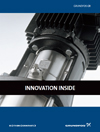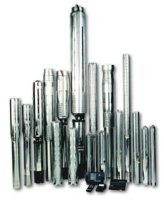SQ/SQE Frequently Asked Questions
General
1. What is the SQ and SQE?
An SQ is a 3" submersible pump bench-marked against the best 4" competitors and with a number of additional integrated protective features.
2. Why can't we just build a 3" stainless steel product similar to the Grundfos SPA?
There are three ways in which the pressure can be increased in a centrifugal pump:
- larger diameter
- more pump stages
- increased speed
When we want a 3" pump we cannot use item 1. Item 2 will make the pump extremely long. We have therefore chosen to increase the speed as the best solution to give higher pressure to 3" pumps.
3. Does the standard SQ model contain a frequency converter?
Yes, the motor has a built-in frequency converter to give the pump high speed, resulting in high performance.
4. What is the difference between SQ and SQE?
The SQ is a single speed pump and the SQE is a variable speed pump which needs a control box to operate with variable speed and to monitor and adjust its features.
5. What is the CU300 and CU301?
The CU300 and CU301 are both control boxes to monitor and adjust the features on the SQE.
The SQE together with the CU300 control box provides advanced features such as constant pressure, monitoring by modem, pump status read out, advanced pressure settings and more.
The SQE together with the CU301 control box and a small tank and pressure sensor, all available in one package, provides an easy to install and operate adjustable constant pressure system.
6. What is the R100?
The R100 is a remote control needed to operate the CU300 control box.
7. Can a SQE be installed without a CU300 or CU301 control box?
Yes, but the pump will then operate as a normal SQ single speed pump. At any time, a CU300 or CU301 can be installed later in order to provide the customer with additional features.
Product Data
1. Which flow volumes will it handle?
Nominal flows up to 7 m3/h and max. flows up to 9 m3/h.
2. How many stops/starts can the pump make an hour in a normal working life?
There are no limitations, it can start immediately after stop.
3. Does SQ have a max. number of restarts built in, before manual reset?
No, it has no max. number of restarts, and it will continue having automatic restart.
4. Is a non-return valve integrated in the SQ?
Yes, and it is also replaceable.
5. How many pressure/curve settings are there on SQE/SQE-NE?
Between min. curve (7.000 rpm) and max. curve (10.700 rpm) for the respective model, it can be adjusted at intervals of 100 rpm.
6. What is the minimum flow required?
Up to 30°C it works without any flow past the motor (free convection).
Up to 40°C it requires a flow of 0.15 m/sec. past the motor.
7. What is the maximum number of starts/hour?
SQ has no limitations, it can restart immediately after stop, continuously.
Applications
1. Can it be used with a generator?
SQ has been designed and tested for use with generators. However, it should only be used with generators with a power size which is min. 10% larger than the power consumption (P1) of the respective motors.
Grundfos recommends not to start the pump until the generator is running.
2. Is SQ mainly for light domestic applications?
SQ has been bench-marked against the best premium 4" pumps and motors and can be used for intermittent as well as continuous pumping without problems. There is even an AISI 316 version with special composite and rubber for demanding industrial and environmental applications.
3. Do I still have to use a pressure tank? If yes, what size?
You still need a pressure tank. The size can be determined from your present experience with our 4" range.
Alternatively you can use SQE with CU300 or CU301 control box for constant pressure regulation, and an 8-litre tank will be adequate.
4. Can you guarantee that SQ can work in horizontal position? What about the heat created on the side touching the bottom of the tank or lake bed?
If you pump clean water and the side of the pump does not touch anything, a cooling sleeve is not required. If the water contains solid particles, we recommend to use a cooling sleeve in horizontal installations.
5. For dewatering, please explain how to use the SQE feature for constant water level regulation.
We refer to our Product Information and Data Booklet which describe this in detail.

Installation
1. Do I have to use an R100 with SQ, SQE and SQE-NE?
No, not necessarily; SQE and SQE-NE could in principle function like an SQ, if you do not make special settings/changes by means of a CU 300 or R100.
For SQ you cannot use R100.
2. What extra electrical protection is needed? Do I need a pulsating DC type of ELCB circuit breaker? - If yes, why? - Can Grundfos supply?
If the pump is connected to an electrical installation where an earth-leakage circuit breaker (ELCB) is used for additional protection, the type of circuit breaker installed must trip when earth fault currents with DC content (pulsating DC) occur. Other types could be disabled by the SQ/SQE motor.
This is a component you get from the installer/wholesaler. Grundfos does not supply circuit breakers.
3. Does SQE have to be in water to set the pressure requirement?
If not, how is it done?
No, you can connect it to CU 300 and change parameters with R100, without starting the motor.
4. What happens if SQ is installed without "ground"?
"Ground" is important to people's safety, and a must to the pump.
5. What happens if SQ is installed without "neutral"?
In order to pump, SQ must be connected both to neutral and one phase.
6. What should be done if SQ replaces an old 3-phase installation?
Make sure that neutral is available, and connect neutral and one of the three phases from the installation to the motor.
Protective features
1. How do I protect SQ against dry-running?
SQ pumps have built-in dry-running protection, without the use of a low level sensor. A preset power value ensures cut-out of the pump in case of lack of water in the well, thus preventing motor burnout.
The software simply checks the power consumption. When it becomes too low, it stops the pump for 5 minutes. After this period, automatic restart is attempted.
SQE will have the power cut-out value programmed by means of R100 during installation. The recommended values can be seen in the instruction manual. In case of changed performance curve, a new cut-out value must be calculated by means of the PC program "SQE - variable speed calculation".
Service
1. Can SQ be serviced?
SQ pumps and motors are fully repairable. A range of spare parts are available. No special tools are required for the replacement.
2. Can I test the motor myself without any special equipment?
The motor must be loaded (e.g. coupled to a pump with counter pressure).
3. Does SQ have a replaceable motor plug?
Yes.
4. Is motor megging possible?
No, the built-in over-voltage protection will short-circuit the megging voltage.
5. Is it possible to check the motor resistance (ohm)?
No, it is not possible, but the motor will not be damaged by the voltage from the ohmmeter.
6. Are any special tools required to service SQ/SQE?
If you want to be able to make full trouble-shooting of SQE, you need a
CU 300 and an R100.
7. You cannot measure the insulation/winding resistance!
No, there is a built-in over-voltage protection which will be short-circuited.
8. Electronics in the well means pulling up the pump in case of problems. Any water leakage or moisture that gets into the electronics means a pull!
The electronics are completely encapsulated in stainless steel, and tested at 15 bar ambient pressure. Electronics could mean that you don't have to pull up the pump, e.g. to adapt it to changing well conditions. Parameters can be changed by means of R100 while the pump is in the well.
Reliability
1. Which cooling conditions apply to SQ?
The cooling of SQ is excellent. In case of free convection, it will operate in liquid temperatures up to 30°C, horizontally as well as vertically, without the need of a cooling shroud. At temperatures up to 40°C, a flow past the motor is required.
2. What is the life expectancy of SQ compared with a Grundfos SPA?
SQ has been bench-marked against premium 4" products, meaning that the pump has been designed so that its life is similar to that of an SPA.
3. Is SQ a plastic pump with a stainless steel outer casing?
The complete motor is made of stainless steel. The pump has stainless sleeve and discharge. Inside it is made of polyamide with 30% glass reinforcement. Each impeller is equipped with tungsten carbide/ceramic bearings, which makes it extremely resistant against sand wear.
4. Is anything special done to check the reliability of the electronic module after it leaves the production line?
Reliability Stress Screening (RSS) is a process which is introduced at production startup in order to fulfil the market (customer) requirement for reliability in the field. See "Nordtest Method NE ELEC" and IEC 1163-1.
5. What about the EMC regulations, does SQ fulfil these?
Yes, SQ meets the EMC regulations regarding electrical noise back on the mains, and radio noise to the surroundings.
6. How will SQ react on large voltage fluctuations?
Nominal voltage is 1 x 200-240 V, -10%/+6%, and it will protect itself by shutting off below 150 V and above 280 V, with automatic restart when the voltage gets within the limits again.
7. Does SQ have soft start?
Yes, it has an integrated soft starter reducing the starting current and thus giving the pump smooth and steady acceleration.
8. Electronics create noise in the mains supply!
SQ meets the EMC regulations concerning electrical noise back to the mains supply and radio noise to the surroundings.
9. What is the lifetime of the permanent magnets? Won't they derate quickly?
The lifetime of the motor is comparable with that of a conventional AC motor. The magnets have been tested to keep their power for minimum 10 years at 120°C, and this temperature is clearly above what they will be exposed to in the motor. Besides, the magnets are completely encapsulated in stainless steel.


